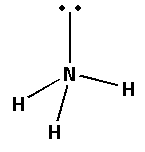
Ammonia is a good complexing agent. Explain with an example.
Answer
554.7k+ views
Hint: We know that any substance that is capable of forming a complex compound with another material in a solution is known as a complexing agent. Ammonia generally forms complexes with metals ions.
Complete answer:
We know that the molecular formula for ammonia is ${\text{N}}{{\text{H}}_{\text{3}}}$. Ammonia is also known as nitrogen trihydride or azane. In the structure of ammonia, three hydrogen atoms are connected to the central nitrogen atom.
The structure of ammonia is as follows:

From the structure of ammonia, we can see that the shape of the ammonia molecule is trigonal pyramidal. The molecule of ammonia constantly undergoes inversion motion.
We can see that there is a lone pair of electrons on the nitrogen atom of ammonia. As there is a lone pair of electrons the ammonia molecule has a good tendency to donate electrons. As there is a lone pair of electrons on the nitrogen atom, the ammonia molecule acts as a good Lewis base.Thus, as ammonia has a good tendency to donate electrons, it has a good ability to form stable complexes.
Thus, ammonia is a good complexing agent.
The example of ammonia as a good complexing agent is as follows:
i) When we test a sample for the presence of chloride ions we use silver nitrate solution. The chloride ions react with silver nitrate and form a white precipitate of silver chloride. The reaction is as follows:
${\text{AgN}}{{\text{O}}_3} + {\text{C}}{{\text{l}}^ - } \to {\text{AgCl}} + {\text{NO}}_3^ - $
ii) When the precipitate of silver chloride is added to the solution of ammonia, the precipitate dissolves in the solution. This is because ammonia forms a complex with silver metal and chloride ions are set free. The reaction is as follows:
${\text{AgCl}} + 2{\text{N}}{{\text{H}}_{\text{3}}} \to {\left[ {{\text{Ag}}{{\left( {{\text{N}}{{\text{H}}_3}} \right)}_2}} \right]^ + } + {\text{C}}{{\text{l}}^ - }$
iii) The complex formed ${\left[ {{\text{Ag}}{{\left( {{\text{N}}{{\text{H}}_3}} \right)}_2}} \right]^ + }$ is the silver-ammonia complex.
Note:Almost all the metals bind to ammonia to form complexes. Ammonia thus, is known as a ligand. Most common complexes of ammonia are with metals like chromium, cobalt, nickel, copper and the metals of platinum group.
Complete answer:
We know that the molecular formula for ammonia is ${\text{N}}{{\text{H}}_{\text{3}}}$. Ammonia is also known as nitrogen trihydride or azane. In the structure of ammonia, three hydrogen atoms are connected to the central nitrogen atom.
The structure of ammonia is as follows:

From the structure of ammonia, we can see that the shape of the ammonia molecule is trigonal pyramidal. The molecule of ammonia constantly undergoes inversion motion.
We can see that there is a lone pair of electrons on the nitrogen atom of ammonia. As there is a lone pair of electrons the ammonia molecule has a good tendency to donate electrons. As there is a lone pair of electrons on the nitrogen atom, the ammonia molecule acts as a good Lewis base.Thus, as ammonia has a good tendency to donate electrons, it has a good ability to form stable complexes.
Thus, ammonia is a good complexing agent.
The example of ammonia as a good complexing agent is as follows:
i) When we test a sample for the presence of chloride ions we use silver nitrate solution. The chloride ions react with silver nitrate and form a white precipitate of silver chloride. The reaction is as follows:
${\text{AgN}}{{\text{O}}_3} + {\text{C}}{{\text{l}}^ - } \to {\text{AgCl}} + {\text{NO}}_3^ - $
ii) When the precipitate of silver chloride is added to the solution of ammonia, the precipitate dissolves in the solution. This is because ammonia forms a complex with silver metal and chloride ions are set free. The reaction is as follows:
${\text{AgCl}} + 2{\text{N}}{{\text{H}}_{\text{3}}} \to {\left[ {{\text{Ag}}{{\left( {{\text{N}}{{\text{H}}_3}} \right)}_2}} \right]^ + } + {\text{C}}{{\text{l}}^ - }$
iii) The complex formed ${\left[ {{\text{Ag}}{{\left( {{\text{N}}{{\text{H}}_3}} \right)}_2}} \right]^ + }$ is the silver-ammonia complex.
Note:Almost all the metals bind to ammonia to form complexes. Ammonia thus, is known as a ligand. Most common complexes of ammonia are with metals like chromium, cobalt, nickel, copper and the metals of platinum group.
Recently Updated Pages
Why are manures considered better than fertilizers class 11 biology CBSE

Find the coordinates of the midpoint of the line segment class 11 maths CBSE

Distinguish between static friction limiting friction class 11 physics CBSE

The Chairman of the constituent Assembly was A Jawaharlal class 11 social science CBSE

The first National Commission on Labour NCL submitted class 11 social science CBSE

Number of all subshell of n + l 7 is A 4 B 5 C 6 D class 11 chemistry CBSE

Trending doubts
What is meant by exothermic and endothermic reactions class 11 chemistry CBSE

10 examples of friction in our daily life

One Metric ton is equal to kg A 10000 B 1000 C 100 class 11 physics CBSE

1 Quintal is equal to a 110 kg b 10 kg c 100kg d 1000 class 11 physics CBSE

Difference Between Prokaryotic Cells and Eukaryotic Cells

What are Quantum numbers Explain the quantum number class 11 chemistry CBSE




